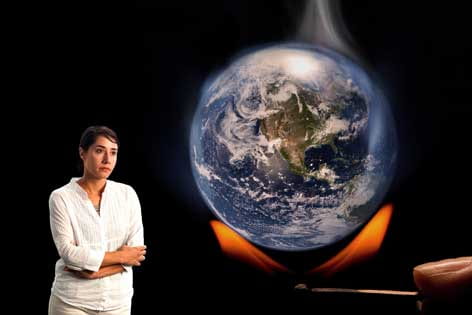Climate change: global problem, local response
UCI’s Diane Pataki discusses strategies for dealing with climate change in Southern California.

Over the last two centuries, people have mined and burned fossil fuels, cleared forests, and developed agriculture and industry. The consequence: rapid atmospheric pollution that is driving climate change.
Diane Pataki, Earth system science and ecology & evolutionary biology associate professor at UC Irvine, discusses climate change, misconceptions about it and what can be done locally to mitigate its impact.
Q: What is the focus of your research?
A: I study the role of urban landscapes in the climate system. Urban landscapes are designed to benefit residents – most often for aesthetics and sometimes to affect climate. For example, shade is commonly cited as a reason that people want trees in their communities. But the environmental effects of trees and other urban landscape components are not straightforward; they involve such tradeoffs as the use of water and fertilizers. My research is aimed at quantifying the tradeoffs so we can make informed decisions about urban land cover.
Q: How is climate change affecting Southern California?
A: Temperatures will probably rise, and because our water supply relies on snow, we may face more severe water shortages. It’s hard to say whether the current drought is caused by climate change. Nevertheless, we need to prepare for more frequent and prolonged droughts in the future. This could alter California’s water supply, agriculture, fire danger and natural ecosystems.
Q: What can we do to mitigate those changes?
A: The best strategy is to avoid future climate change by addressing the causes. We must reduce our greenhouse gas emissions, develop methods of removing it from the atmosphere, or somehow direct radiation away from the Earth’s surface. Since we don’t have a cost-effective, large-scale technological solution, it’s prudent to do what we can to reduce greenhouse gas emissions. Still, climate change is likely, so we should consider adaptation strategies – ways to deal with changes that can’t be avoided. My laboratory is exploring methods of curtailing urban landscape water use in response to declines in Southern California’s water supply.
Q: What are some common misconceptions about climate change?
A: My lab deals with misconceptions about the role of urban forests in mitigating climate change. People are utilizing tree-planting programs to try to solve a lot of environmental problems, including climate change. But, unfortunately, cities emit much more carbon dioxide than urban trees can take up. This doesn’t mean we shouldn’t have tree-planting programs, but they have to be carried out wisely. In Southern California, trees have to be irrigated. We should think carefully about what kinds of trees to plant – and where – to avoid worsening water shortages.
Q: What interests you about the changing climate?
A: I’m interested in how vegetation affects the climate system. We’re beginning to recognize that the “green slime” covering the Earth’s surface plays a huge role in regulating climate. Now that we know this, we can direct our research toward making better decisions about managing vegetation. Deforestation, agriculture and urbanization have had many unintended consequences. We must balance the services we get from ecosystems, such as food production, with the environmental costs of greenhouse gas emissions and climate modification.
Q: What do you like best about UCI?
A: I came here because of the people – my great colleagues and students. But I have to admit that, like everyone else, I love the Southern California climate. Let’s try to keep it this way!